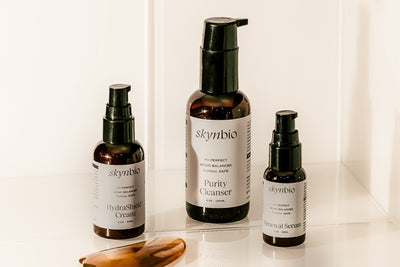When you think of acne, you probably picture red, inflamed pimples caused by clogged pores and excess oil. But not all acne is the same – there’s a type often mistaken for traditional acne that’s actually caused by a fungus, not bacteria. This is known as Malassezia folliculitis, or more commonly, fungal acne. Understanding the difference is key to treating it effectively and supporting long-term skin health.
What Is Fungal Acne?
Fungal acne occurs when there’s an overgrowth of Malassezia yeast, which naturally lives on your skin. Unlike bacterial acne (which forms due to clogged pores and excess oil), fungal acne develops when yeast enters hair follicles, triggering inflammation and small, uniform bumps.
🚨 Key Signs of Fungal Acne:
✔ Clusters of tiny, uniform pimples—often on the chest, back, shoulders, or face.
✔ Itchy, red, or inflamed skin—especially in humid or sweaty areas.
✔ Breakouts that don’t respond to traditional acne treatments.
Fungal Acne vs. Bacterial Acne: What’s the Difference?
| Feature | Fungal Acne (Malassezia Folliculitis) | Bacterial Acne |
|---|---|---|
| Cause | Overgrowth of Malassezia yeast | Clogged pores, excess oil, bacteria |
| Appearance | Clusters of small, uniform bumps | Varied size pimples (whiteheads, blackheads, cysts) |
| Location | Chest, back, shoulders, face | Mostly on face, T-zone, jawline |
| Itchy? | Yes, often itchy or irritated | No itching |
| Triggers | Humidity, sweat, oils, fatty acids | Hormones, diet, poor skincare |
| Treatment | Antifungal, microbiome-balancing products | Salicylic acid, benzoyl peroxide, retinoids |
❌ Traditional acne treatments like benzoyl peroxide or salicylic acid often make fungal acne worse by disrupting the skin microbiome, allowing yeast to thrive even more.
What Causes Fungal Acne?
Several factors can lead to Malassezia overgrowth and trigger breakouts:
🔥 Humidity & Sweat – Hot, humid climates and excess sweating create the perfect breeding ground for yeast.
🧴 Heavy Skincare Products – Fatty acids, oils, and esters in moisturizers and creams can feed Malassezia.
💊 Antibiotic Use – Overuse of antibiotics kills good bacteria that normally keep yeast in check, causing an imbalance.
💪 Compromised Skin Barrier – A weakened barrier allows Malassezia to penetrate more easily and thrive.
How to Treat and Prevent Fungal Acne
Because fungal acne is caused by yeast, targeting bacteria won’t help. Instead, focus on antifungal and microbiome-supportive skincare:
Switch to Fungal-Safe, Microbiome-Supportive Products
✔️ Use lightweight, oil-free, non-comedogenic formulas that don’t feed Malassezia.
✔️ Avoid fatty acids, esters, and pore-clogging oils.
✔️ Use products that actively support your skin’s barrier, like ceramides and niacinamide.
Shower After Sweating
✔️ Sweat creates an ideal environment for fungal acne – always shower and change into dry, breathable clothing after workouts.
Balance Your Barrier
✔️ Avoid over-exfoliating and stripping cleansers that disrupt your skin’s natural barrier.
✔️ Choose products like the Skynbio Clear Balance Trio that support a balanced microbiome and healthy barrier function.
💡 Why Skynbio is Different
Instead of just avoiding problem ingredients, Skynbio uses science-backed actives that hydrate, repair, and protect your barrier while supporting a balanced microbiome:
🌿 Purity Cleanser – Gently cleanses without disrupting the microbiome.
💧 Renewal Serum – Hydrates, calms inflammation, and regulates sebum without feeding yeast.
🛡️ HydraShield Moisturizer– Lightweight, barrier-strengthening hydration without heavy oils.
Struggling with fungal acne? Shop the Clear Balance Trio and start your journey to clearer, healthier skin.




